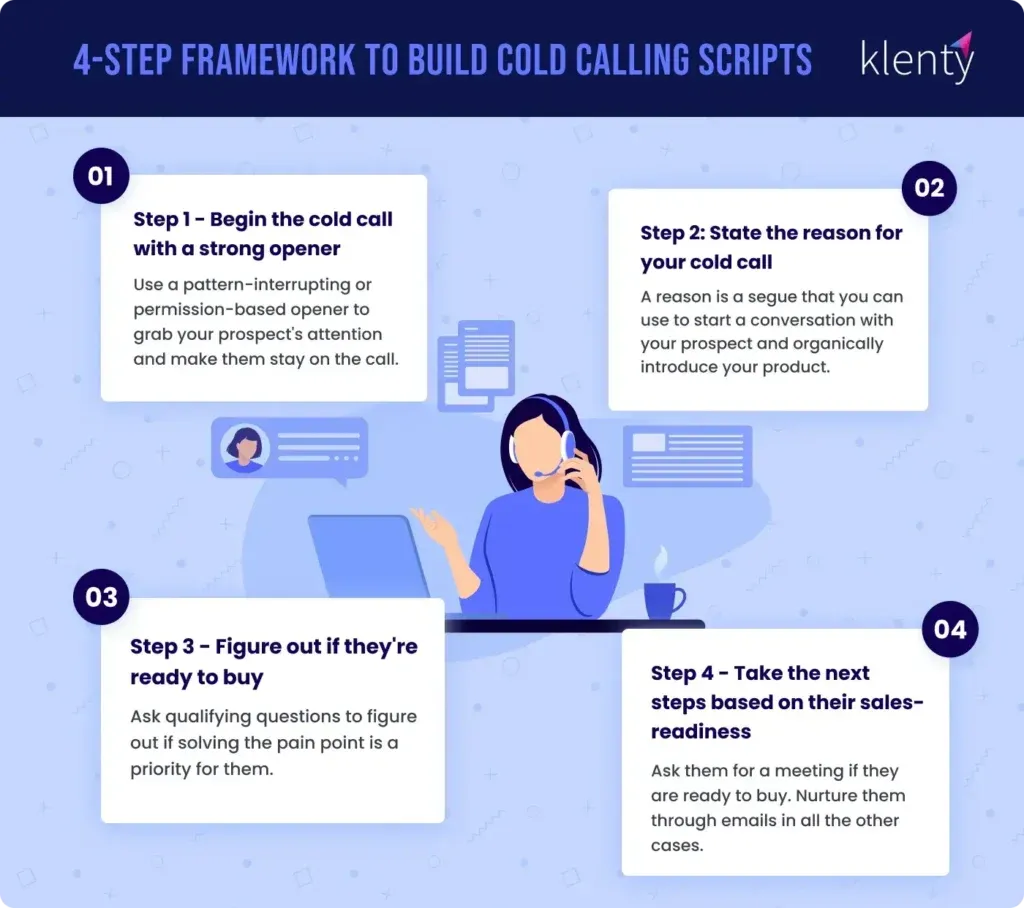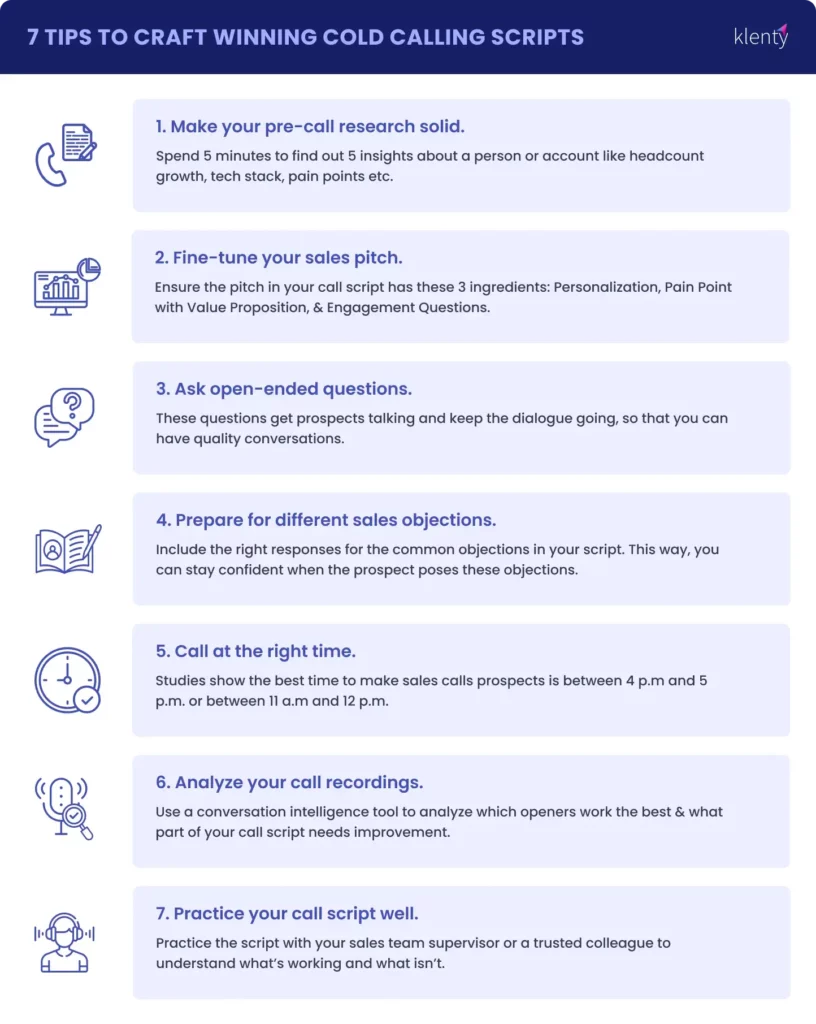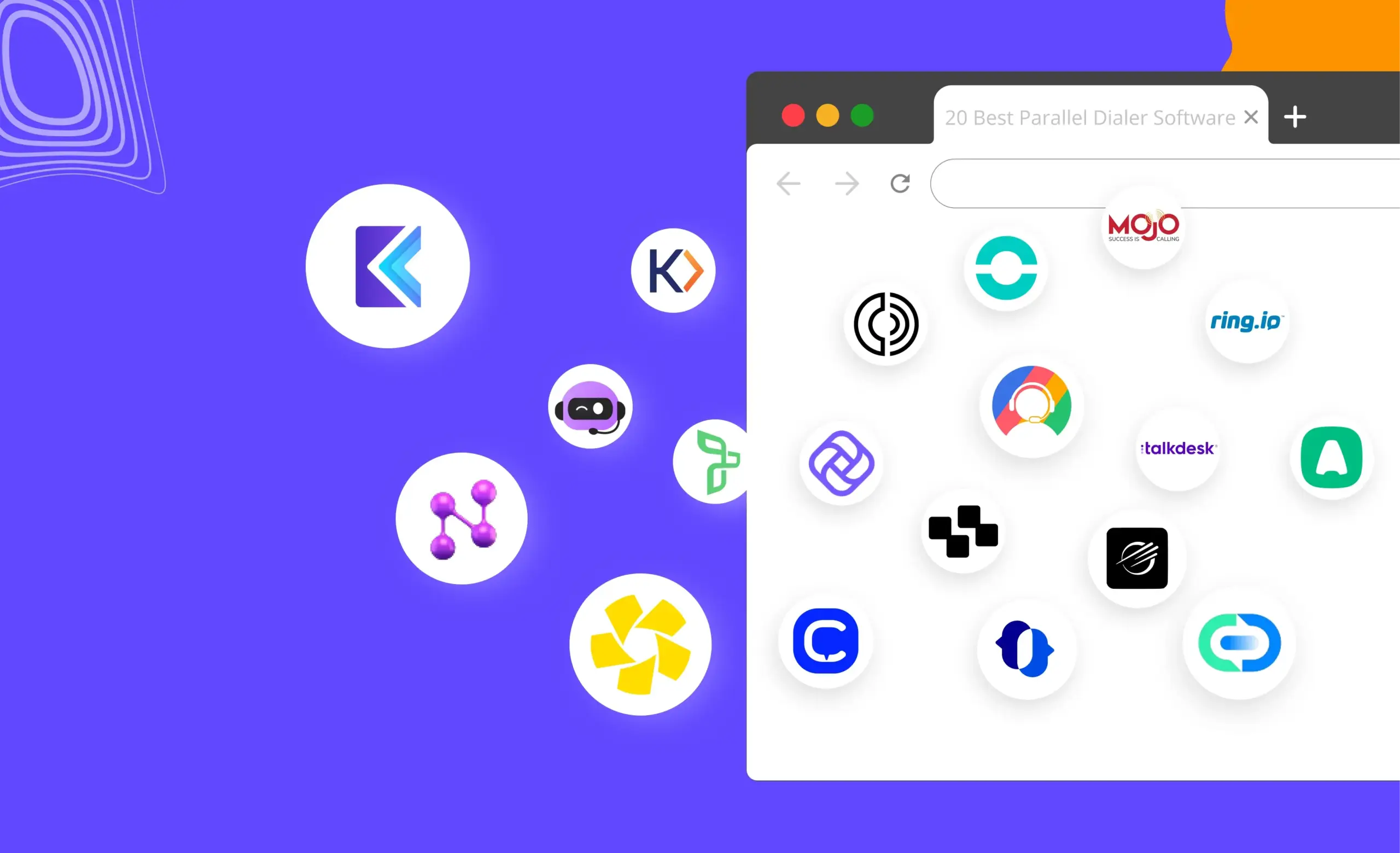Cold calls are inherently unpredictable.
You call your prospects for the first time, and they’re not expecting your call. A myriad of situations can ensue when prospects connect with you.
So, making a cold call without having a plan in place can be like walking into a minefield blindfolded.
What’s the one thing that can reduce the unpredictability of cold calling and help you navigate calls successfully?
A cold call script.
In this article, we're going to give you over 25 battle-tested cold calling scripts and 7 expert tips that will help you take back control of your calls and ace your game like you always wanted to.
What Is a Cold Call Script?
Cold calling scripts are roadmaps for the sales conversation that reps hold with prospects during cold calls. A good cold call script helps SDRs maintain a smooth conversation with prospects.
The typical call script you use contains cold call opening lines, your solution’s value proposition, questions that help you assess a prospect’s sales readiness, and answers to some of the questions and objections they might pose during the course of the call.
Despite the emergence of new outreach channels and the rampant pessimism about the practice in general, cold calling remains one of the fastest ways for sales reps to connect with prospects and get a meeting booked.
Why Should You Use Cold Call Scripts?
- Helps you be mindful of what you are saying. While your cold call should ideally feel like a spontaneous interaction, getting on the phone impromptu might lead to awkward pauses, filler overuse, and clumsy delivery. But having a sales call script helps you avoid cold calling mistakes, stay mindful of what you say, and convey your sales message confidently.
- Prepares you to face cold calling objections. You are bound to get objections in sales calls, at least in most cases. These scripts help you handle cold calling objections and be prepared to face them head-on and turn them into opportunities.
- Sound more confident during cold calls. With a sales script in place, you enter the call prepared to handle different situations that could arise. This helps mitigate any fear of cold calling you might have and helps you sound more confident during your calls.
- Ramp up your calling skills quickly. Sales cold call scripts give new SDRs a framework to work in so they won't get stuck anywhere due to misconceptions or confusion about what to say and what not to say during a phone call.
The bottom line: Call scripts help you speed up the ramp-up process if you’re new to cold calling and helps you see results quickly.
SDR-Verified B2B Cold Calling Scripts to Book More Meetings
Best Cold Calling Openers To Catch Your Prospect’s Attention
No one is waiting for a sales call to get sold on some grand idea. The cold truth is your prospects might be preoccupied with a million other things when you make the out-of-the-blue call. So if you don't grab their attention and interest them enough at the opening of your call, they sure are going to hang up and go on with their life. Here are 5 openers to arrest your prospect's attention.
1. When You Use a Trigger Event
Hi James, it's Mike with Sky Securities.
I believe you took part in a webinar on Data Loss Prevention last Wednesday. Is that right?
"Yes."
One of the things that struck me was how most of the recent cyber-attacks happened via HYPP. As a company which uses HYPP as the major communication channel, what measures have you taken to prevent this from happening?
(Start asking qualifying questions based on their responses.)2. Referral From the Prospect’s Colleague
Hi Emilio, it's Maria with Prolific.
I just got off a call with Tyler from the Product team. He says you are actively looking for a solution to streamline and speed up the process of your dev team. Is this the right time to talk?
"Yes."
Great. I'll first ask you a few key questions to understand your situation and see where we can fix your dev team's process. Sounds good?
"Yes."
Great. Now tell me Emilio…
(Start asking qualifying questions based on their responses.)3. When You Get Referred by Your Mutual Connection
Hi Leon, it's Mia with ThriveSpace.
I was speaking with Lucas at Kikazz Softwares the other day, and he said you are actively
looking for a new office space to accommodate your growing team.
We've been helping startups like yours rent affordable office spaces in the Buffalo city area. Most recently, XSoft rented a 100-square-foot office with us, cutting their overhead cost by almost 15%.
I thought I'd reach out to you to see how I can help you with your situation. I hope I didn't catch you at a bad time.
"No, go ahead."
Awesome, could you help me answer a few questions so I can get a clear idea of your situation?
"Yes."
Perfect! Now tell me Leon…
(Start asking qualifying questions.)4. Hyper-Personalized Cold Calling Scripts
Hi Luke, it's Sara with Xenex. Congrats on your promotion! Going from an SDR to an SDR manager in just 8 months is no easy job!
As someone with similar career goals, I couldn't help but call you right away! I hope it is a good time because I'm really excited to know more about your journey and how you made it.
(Be genuinely interested in your prospect's journey. Build the rapport and slowly steer the conversation to introduce your offering in a subtle manner.)5. When You Follow Up After a Call-Back Request
Hi Aaron, it's Anita from Hybevent. You had asked me to call you back today. Hope it is a good time to talk.
"Yes."
So, Aaron, I came to know that Codify's annual summit is in 2 months. How are you planning to handle check-ins this time? I'm asking because I've heard that delayed check-ins are among the most common reasons for low attendee satisfaction.
(Ask more qualifying questions based on their response.)6. Following Up After Sending a Cold Email
Hi Robert, it's Amelia with iCandy. Does that name ring a bell?
(The prospect responds with a yes or no, depending on whether they've noticed your email.)
Yeah, I had sent you an email this Wednesday about how optimizing Skypark's website could increase your traffic by 20% in under 3 months.
I thought I'd reach out to you and see if you are interested in hearing more about that. Do you have a minute?
(If "Yes")
Before I tell you more about our solutions, shall I ask you a few questions to better understand your situation?
(If "yes")
(Start asking qualifying questions.)7. Cold Call Script to Re-Engage With a Lost Lead
Hi Sophia, it's Lucas from Supernova.
Three months ago, you showed interest in making a TV spot for Coco Drink because there was a slump in sales in the last quarter. But since the allocated budget had to be redirected into some other campaign, you decided not to move forward with the idea.
What does the situation look like for you now?
(Prospect responds)
Oh, that's nice.
(Start asking qualifying questions.)11 Common Sales Objections and Ways To Handle Them
Despite how awful and discouraging they might sound, objections present an excellent opportunity to explore your prospect's hidden challenges and requirements and help you keep qualifying them better.
Ashley Dees, SDR manager at Metadata, considers every objection as an opportunity to put a smile on her prospects. In a series we ran called the 'SDR X Factor,' she told us, "When I'm reaching out to people, I like to have fun. I really enjoy making people laugh personally. So anytime I'm able to do that, I will".
Here is a list of simple yet powerful responses to tackle cold calling objections like a pro.
Pro Tip: 54.3% of high-performing reps use questions to deal with objections. Through questions, you’ll be able to dig out the real reason behind objections and handle them better.
1. I’m Not Interested
Option 1:
"{Prospect name}, it's absolutely reasonable to not be interested in my first call to you. I'd like to give us an opportunity to schedule a more formal time. In the meantime, I'll email you a few wonderful success cases that might gain your interest.
If it does, and I think it will, I'd love for us to keep our appointment, if not then you shouldn't be interested." Why it works: When prospects tell you "I'm not interested," using the above script can achieve 3 things: Making the prospect feel understood, making them curious about your offering, and, most importantly, exploring the possibility of getting a formal meeting with them.
Option 2:
"Do you think I can touch base with you sometime later? Do you think your priorities would change?"Why it works: Bugging prospects about why they are not interested in your product can only push them further away. Instead, when you shift your prospect’s focus from their disinterest in your product to chances of future collaboration, they tend to give more positive responses. Nanditha Menon, BDR at G2, claims asking this might help you secure another meeting with prospects as they tend to give an alternative date and time.
2. Mail Me the Information
Option 1:
"I'd be glad to do that. Can you tell specifically what kind of information will help you?
{Prospect responds}
That's interesting, why is that important?"Why it works: This one from Jim Dunn’s ‘Common Sense Selling’ subtly moves the prospect from asking you to send them an email and hanging up the phone to continuing to answer your qualifying questions.
Option 2:
"Sorry to say this, but most people who ask me to mail the information never reply. If you have 2 minutes, I'll tell you why I called."Why it works: Prospect might understand your situation and agree to listen to you. Also, by going for a small ask, like 2 minutes of their time, you encourage them to let their guard down.
3. We Have Everything We Need
Oh that's great! But as you know, there's always room for improvement. I did a bit of research on {prospect's company} before calling you and I found that {prospect pain point}. I figured out we could help you {tangible result}.
I can mail you the information if you want, and you can get back to me if you're interested. Sounds good?Why it works: The response lets your prospect know that you have actually done your research. And since you are providing value in the form of research, the prospect is more likely to share the email address with you.
4. Too Busy Right Now, Call Back Later
Option 1:
"Oh, that's fine. How about I call you later this evening/tomorrow morning at {specify time}?Why it works: First, you are being respectful of their time. Second, when they say they don’t have time and you get them to commit to a specific time, so there's no confusion as to why you should make the callback.
Option 2:
"When would be a good time to call you back?
{When the prospect gives a time}
Can I take 30 seconds to tell you why I called?"Why it works: According to Joel Thomas, top-performing SDR at Almabase, asking prospects if you can tell them why you called, in 30 seconds, gives you an idea about why they used this objection. "Some people are genuinely busy—they're probably in a meeting or something, and then you don't want to interrupt that. But some people just want to brush you off," says Joel.
5. Call Back Next Month or Quarter
"Sure. I'd be glad to. Out of curiosity, is {prospect company} investing in {big commitment - like product, acquisition} in the meantime? Why it works: When a prospect asks you to call back after a certain period, typically a quarter or 6 months, there's a high chance that their company is engaged in some important project or going through a transition. This response will help you know what that is and further qualify your theme.
Note: If you are going to give a prospect a follow-up call after a few weeks or months, keep your prospects in the loop by regularly sending them emails with information that interests them in the meantime. That way, you won't come off as a cold caller the next time.
6. This Isn’t a Priority Right Now
"Ok, that's fine. Would you be open to discussing this if I call you back in a month or two?"
Prospect responds
Great! Meanwhile, we have some interesting resources on {subject matter that interests your prospect}. I can send it to you by email. Would you like to receive it?Why it works:
Even though you're delaying the discussion by a few weeks, you are securing their email address which you use to warm up the prospect on a regular basis.
7. I Need To Think About It
{Prospect name}, I understand that thinking about it might make sense right now, but can you help me understand what's exactly holding you back? Why it works: "I need to think about it" always means the prospect isn't convinced or clear about something. That's why it's important to know what is bothering them before you ask other questions. This script from Mike Brook’s ‘Power Phone Script’ does exactly that.
8. I’ll Need To Discuss This With Person X
"I understand, {prospect name}. If it's alright with you, I'll be happy to reach out to {person X/decision maker} directly and answer any questions they might have. Would that be okay?"
If "yes," ask for their number and go ahead.
If "no," say, "That's okay. Quick question, though, "Do you think {person X} would like to hear about this?"Why it works: Also, from Mike Brook's 'Power Phone Script', this clever response will either get you to speak directly with the decision maker or know more about them.
9. We Already Have Competitor X Product/Service
Option 1:
"Oh, that's okay. Just a quick question, how would you rate 'competitor' on a scale of 1-10?Why it works: Just because the prospect is already using a competitor's product or service, it doesn't mean the doors are shut forever. When a prospect tells you that they're using another tool, the above response helps you explore future goals and aspirations of prospects and other interesting information.
Option 2:
"Our goal isn't to make your transition. Nor is that my job, actually. My job is to reach out to you, and talk about your business and see if we can maybe provide a solution for you, make your life a little easier. Our goal is, we want to show you the platform and show you why people are using our platform, and then the transition is up to you."Why it works: Sam Holeman, SDR at Momence, shared this strategy when we interviewed him for our SDR X Factor series. He calls this the “reframing the conversation” strategy. When you take a solution-focused approach, where you are more interested in how your prospect can benefit from the product, you coax them to trust and open up to you.
10. I Heard That {Something Bad About Your Product/Service}
"Sorry to hear about that/Thanks for bringing this up, {prospect name}. Could you be more specific on what you heard about {product/service}?"Why it works: Just like a customer service representative, you are trying to empathize with the prospect and are trying to dig deeper into what exactly they are concerned about. Make sure you sound genuinely concerned about their feelings and determined to clear up the doubts.
11. We Don’t Have the Budget
"I completely understand that you may not have the budget right now. The reason why I’m calling you is to show how we can help you [solve or achieve XYZ]. I’d like to offer a no-obligation demo for you to make an informed decision for your team. If you like what you see, we can figure out the next steps together, and if you don’t, you can walk away no strings attached. Does that sound fair?"Why it works: When a prospect tells you that they don't have the budget to buy your solution, you offering a no-obligation demo empowers them to make an informed decision without financial commitment. They can evaluate your solution's features, benefits, and suitability for their specific requirements, which ultimately increases the likelihood of them considering your solution in the future.
Cold Calling Scripts To Get Past the Gatekeepers
If there's one person that salespeople want to avoid at all costs, it would be the gatekeepers. Gatekeepers are experts at snapping your calls short and making you feel stupid. But consider this, they know a great deal about your prospects, and that information could save you tons of time and the overall success rate of your cold call.
However, you can't get anything out of them if they sound harsh or dominating. When speaking with gatekeepers make sure you sound polite and professional. "We shouldn't be disingenuous, you shouldn't tell them lies because they can see through that. It's their entire job to keep salespeople out," says Joel, in our ‘SDR X Factor’ series.
Here are two scripts to help you work with the gatekeeper:
Working With Assistants, Secretaries, and Other Screeners
Hi {gatekeeper name}, it's {your name} with {your company}. I'd like to speak with {prospect name} to discuss {specify prospect's pain point and your possible solution for it}. But just to make sure I don't waste his/her time, you could perhaps help me answer a few questions. Is that okay with you?
"Sure. Go ahead"
"Great!"
Now, proceed to ask qualifying questions like…
1. When is the best time to reach {prospect name}?
2. Which is the preferred medium of communication for {prospect name}?
3. Who usually makes the decision regarding X?
Thanks a lot {gatekeeper name}, I'm glad I reached you. Now if the {prospect name} is available, could you please connect me with him/her?Why it works: By explicitly stating that you don't want to waste the prospect's time and asking them to help with that, you are making the gatekeeper's job easier – which is to save the prospect's valuable time – and hence would be happy to divulge information you could have never found on the internet.
Working With Receptionist
Hi, it's {your name} with {your company }. Put me through to
{prospect name} in the {prospect department}, please.
"Sure, hold on a second"
If the receptionist asks: "What is this about?"
"Please tell her/him it's {your name} with {your company} and calling about {specify a prospect's pain point and your possible solution for it}.Why it works: By instantly asking them to connect you with the prospect department, you can save time explaining the reason. The key here is to sound important, polite, and familiar at the same time.
Common Gatekeeper Objections and Responses
Objection #1: Were they expecting your call?
I had mailed {prospect name} earlier, informing him/her that I'd be calling today.
Objection #2: They are in a meeting. Call later.
Alright. May I know when would be the right time to call {prospect name}?
Objection #3: They are out of town/‘ve gone on vacation.
Oh, alright. May I know when {prospect name} will be back in office?
Objection #4: Email the information.
Sure. I'd be glad to do that. But first, just to make sure the information is relevant and useful to {prospect name}, I'll need to ask them a few important questions.
Cold Calling Voicemail Scripts To Get a Call Back
Most salespeople are convinced that voicemails are a waste of time. They can't be more wrong. While it’s true that the average response rate of voicemails is a mere 4.8%, consistently leaving effective voicemails could dramatically increase your chance of getting a callback. That said, here’s 5 scripts to nail your voicemails:
1. Voicemail Script When You Want a Call Back
Hey Peter, it's Boris with SmartOffice. I'm reaching out because I came across your post on LinkedIn about how the back office work in your store is eating up a lot of your workday.
We've helped many small business owners like you in the Michigan city area to run a leaner back office and spend 50% time managing their store. And I'm sure I can help you as well.
Let's hop on a quick chat to discuss more. Here's my number 1234-5678. Again, it's Boris with SmartOffice calling from 1234-5678.Note:
Always repeat your name, your company name, and your contact number at the end of your voicemails so the prospect doesn't have to replay the message to get all the details.
2. Voicemail Script When You Want To Direct Them to Your Email
Hey Voss, it's Bob with GRX. I know you are super busy. You don't have to call me back. I've sent you an email with the subject line 'Your Email Marketing Spend', and if you find it interesting, please reply to the same email. Again, you don't have to call me back.Though this voicemail script negates the whole purpose of leaving voicemails, this is super-effective, according to our SDRs at Klenty. Doing this gives you an effective opener for your next call - your mail.
How To Create a Cold Calling Script in 4 Steps?
A strong cold call script primarily has 4 elements:
- An opening line
- The reason for the call
- Questions to gauge sales-readiness
- Closing section to discuss the next steps
To help you include all of these elements in your cold calling script, here's a simple 4-step framework to help you create your own call script:

1. Begin the Cold Call With a Strong Opener:
Your openers should achieve two things: Get your prospect's attention and intrigue them enough to stay on the call. Here are two types of cold call openers that you can use to grab their attention:
1. Pattern-Interrupting Openers
Pattern-interrupting openers are like a red dot in a sea of white dots. It catches the prospects off guard and makes them go, 'Wait, what'?
Here's an example of one such opener used by SDRs at Klenty all the time:
Hi Alex, this is Kevin from HYPP. Can I brighten your day with a cold call?2. Permission-Based Openers
Permission-based openers seek prospects' permission to continue before you get to the reason for the call.
"People take it more as a sign of respect, that you're making sure it's okay to continue your pitch when you call them out of the blue", says Ashley Dees, SDR Manager at Metadata.
Here's a permission-based opener she uses during cold calls:
"Hey, Kim! Ashley from Metadata. We haven't spoken before. Do you have a minute to chat?"If she senses that the prospect is in a noisy environment like being stuck in traffic, she modifies her opener:
"It sounds like it's not a great time. Sounds like you're driving, and I don't want to bother you. Is it okay if I call you back tomorrow afternoon?"2. State the Reason for Your Cold Call
Once you have your prospect's attention, tell them why you are calling. Ideally, this is the part where you explain the reason for your call and convey the relevance of the message.
The reason for your call is never to pitch your product. In fact, selling is the last step in the process. Instead, find a segue that you can use to start a conversation with your prospect and organically introduce your product. Research your prospect using sales intelligence tools and social media channels to find the perfect segue that is relevant and personalized.
Here's an example:
So, Aaron, I came to know that Codify's annual summit is in 2 months. How are you planning to handle check-ins this time? I'm asking because I've heard that delayed check-ins are among the most common reasons for low attendee satisfaction.3. Figure Out if They’re Ready To Buy
There's no one-size-fits-all formula to find the buying intent of prospects. The only way to find it is by asking them a series of qualifying questions based on the prospects' responses.
No matter the number or kind of qualifying questions you ask, by the end of this stage of cold calling, you should know 3 things:
- Are they aware of the problem they are facing?
- Is solving the problem a priority?
- Do they have a tool in place to solve the problem?
Pro Tip: You can use sales models like SPIN, MEDDIC, NEAT, and GAP to frame specific qualifying questions to fish out more information out of your prospects.
4. Take the Next Steps Based on Their Sales-Readiness
Your prospects' responses to your qualifying questions will give you a clear idea about how sales-ready they are. You can segment your prospects into two based on their sales-readiness (buying intent):
- Prospects With High Buying Intent
These are sales-ready prospects who are aware of their pain points and are ready to solve it right now. The next logical step for them is to book a meeting with you.
- Prospects With Low Buying Intent
These are prospects who aren't ready to buy from you yet. They might or might not be aware of the problem, but solving it isn't a priority for them. So, never ask them for a meeting instead, warm them up by sending relevant resources through email. Get them familiar with your brand and nurture them with value so they'll choose you when the time comes.
7 Cold Calling Tips To Get the Most Out of Your Scripts
Nearly 9 out of 10 sales reps feel burned out, a Gartner survey says.
B2B sales is hard. And cold calling is harder. Only 2% of your cold calls end up in a booked meeting, according to cold calling statistics based on research.
So, when you craft a cold calling script with the 4 steps we covered earlier, and take inspiration from these tried-and-tested cold call scripts in this blog, you’ll see positive results and end up enjoying cold calling.
But this isn’t the full picture here.
To make sure you get the maximum out of your cold call scripts, here are 7 expert cold calling tips that you can make use of in your calling workflow to get the best results out of your sales call script every time:

1. Make Your Pre-Call Research Solid
Researching your prospect is key to making your cold calling script work.
To scale personalized outreach and standardize your research, sales expert Kyle Coleman recommends spending 5 minutes to find out 5 insights about a person or account. Spending more time than this will hit your productivity.
Depending on your sales strategy, you can find some vital info about your prospect like:
- Headcount growth: To understand the company's goals, growth rate, and potential needs for your product.
- Tech stack: To learn about their existing tools/software/applications and determine if they can afford your product.
- Job advertisements: To check job descriptions and understand their current processes for different departments and positions.
- Prospect's background: To know how long they've been with the company, recent promotions, etc. to tailor the conversation according to their role and pain points.
- Company's mission: To align your value proposition with their goals and vision.
- Common industry pain points: To identify common challenges in the industry and position your product as the best solution.
2. Fine-Tune Your Sales Pitch
Your prospect usually gives you the first 30 seconds. After this, if you’ve piqued their interest, you can go ahead. Otherwise, it’s a hard rejection.
To avoid the second scenario, make sure the sales pitch in your cold call script has the following 3 ingredients baked into it:
- Personalization: The pitch must talk directly to the prospect and not sound generic.
- Pain Point with Value Proposition: The pitch must raise a pain point familiar to the prospect while highlighting what makes your solution worth their time.
- Engagement Questions: It’s not a monologue but a conversation. Include questions like “Have you tried addressing this pain point previously?” or “Does {Solution} help you streamline problems effectively?” to engage the prospect and have them participate in the cold call as well.
3. Ask Open-Ended Questions
To strike up a meaningful conversation with your prospects and book more meetings, make sure you have the right cold calling questions in your cold calling script.
As a general principle, stick to asking open-ended questions from start to finish of your call. Open-ended questions get prospects talking and keep the dialogue going, so that you can have quality conversations.
The opposite of this is closed-ended questions, which can simply be answered with a yes or no. Keep these to a minimum, as asking too many yes/no questions can make the call feel like an interrogation instead of an interaction.
Example of a closed-ended question: “Are you the decision maker?”
Example of an open-ended question: “May I ask you how many people are involved in decision making in your organization?”
4. Prepare for Different Objections
Obviously, not every prospect who answers your cold call will be sales-ready. These prospects will pose objections, which are basically reasons why they don’t want to buy from you.
So, learning to handle cold calling objections becomes essential—not optional—for you to book their meetings through cold calling.
Some of the common cold calling objections you might encounter are:
- “I’m not interested.”
- “Send me an email.”
- “We’re using another tool.”
- “I don’t have time.”
- “We don’t have the budget.”
- “How did you get this number?”
Anticipating these objections, prepare the right responses and incorporate them into your cold calling script. This way, you won’t be caught unawares when your prospect gives you one of these objections.
By handling objections, you’ll boost your prospect’s confidence in your solution. Sometimes, all that stands between you and a booked meeting is just an objection.
5. Call at the Right Time
As cold calling is widely perceived to be an intrusive practice, the difference between a successful cold call and a line left ringing has much to do with timing. So, it’s worth knowing the best times to make cold calls.
As per an analysis by CallHippo of 15,800 call attempts, the best time to make sales calls prospects is between 4 p.m and 5 p.m.
The second-best time, according to the same study, is between 11 a.m and 12 p.m, right before lunch.
Another key finding here is that Wednesday is the best day to make cold calls, followed by Thursdays and Tuesdays.
6. Analyze Your Call Recording
Once your callblocks are over, go back and examine your call recordings. This will help you identify what works in your cold call script and what doesn’t.
However, manually listening to recordings can be time-consuming. This is why you need a conversation intelligence tool. This convenient solution transcribes, summarizes, and generates reports on your calls, ready for you to leverage during your cold call training session.
Conversation intelligence software helps you identify:
- Which of your cold call openers work the best
- What part of your call script needs improvement (value proposition, objection handling, etc.)
- Common cold calling mistakes you could be making
- Whether you're monologuing a lot or maintaining the right talk-to-listen ratio.
7. Practice Your Call Script Well
No matter how good your cold calling script is, if you fail to deliver it well, it’s as good as useless. For this reason, be sure to practice the script adequately before getting on the call. Here are a few pointers on getting your call script practice sessions right:
- While practicing your cold calling scripts, aim for a downward inflection in your tone of voice. Josh Braun, a sales expert, says a downward inflection in your voice helps make you sound confident and sure of yourself while increasing the chances of a prospect opening up to you and feeling comfortable in the conversation.
- Work on your active listening skills. By practicing active listening in cold calls, you make sure that you don’t rush through your script. You stay flexible and allow the conversation to unfold naturally, which lets prospects hold longer conversations with you.
- You can practice the call script with your sales team supervisor or a trusted colleague to understand what’s working and what needs improvement.
On to You
At the end of the day, it's your call, and they are your prospects. So use these scripts as a starting point to build your own. Once your own cold call script is ready, practice it a dozen times to see where it sounds a bit off and tweak it accordingly. Finally, keep testing out your script in the real world and keep refining it for best results.
Happy prospecting!
Resources You'll Love
FAQs
How do you write a good cold-calling script?
1. Begin with a pattern-interrupting introduction
2. State the reason for the call and give social proof to build their trust
3. Include qualifying questions to gauge their sales readiness
4. Take the next step based on their sales readiness
What do you say at the beginning of a cold call?
"This is Anne from Xenox. Can I brighten up your day with a cold call?" is one example of breaking the pattern in cold calling.
How many cold calls should SDRs make per day?
Here's the breakdown:
2 minutes for research + 30 seconds for ringing + 1 minute 20 seconds talk time + 30 seconds for leaving a voicemail + 30 seconds for CRM update = 4 minutes 50 seconds
4 minutes 50 seconds * 5 hours = around 62 cold calls daily
What do you do in the first 20 seconds of a cold call?
Here's one such example from Sam Holeman, best-performing sales rep from Momence:
"We've worked with a lot of people who have used {competitor} in the past and just haven't been happy with their software or looking for something more modernized. I had this idea for you."





